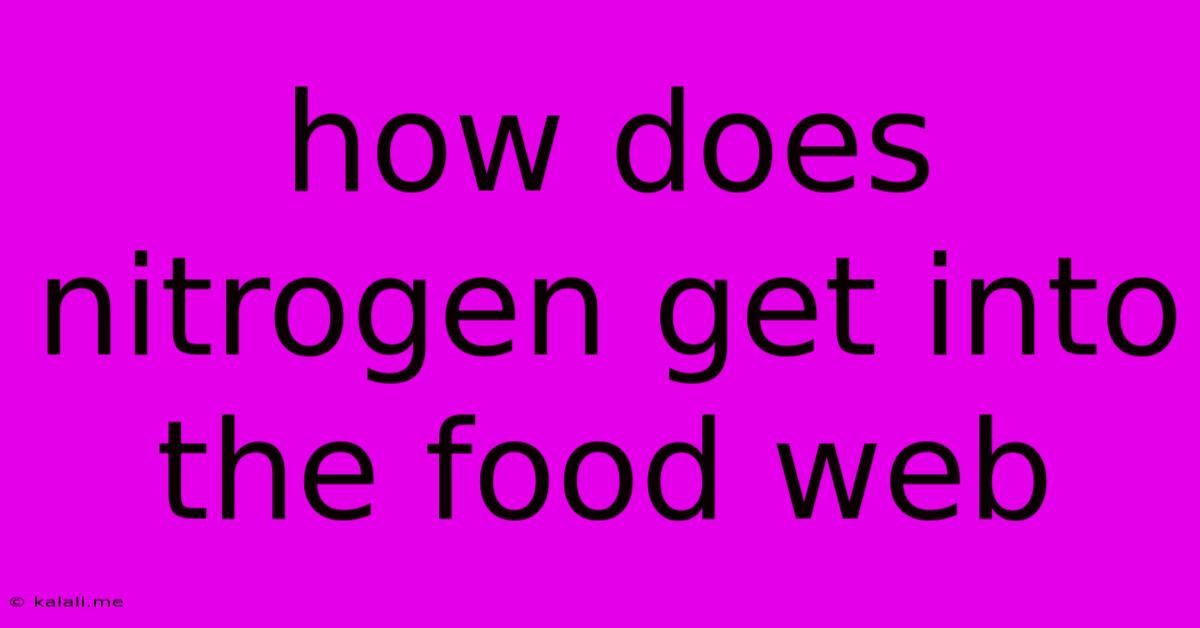How Does Nitrogen Get Into The Food Web
Kalali
May 09, 2025 · 3 min read

Table of Contents
How Does Nitrogen Get Into the Food Web? A Journey Through the Nitrogen Cycle
Nitrogen is an essential element for all living organisms, forming a crucial part of amino acids, proteins, and nucleic acids – the building blocks of life. However, atmospheric nitrogen (N₂), which makes up about 78% of the air we breathe, is largely unusable by most organisms. This is because the strong triple bond between the two nitrogen atoms makes it incredibly difficult to break. So, how does this vital element enter the food web? The answer lies in the fascinating and complex nitrogen cycle.
This article will explore the key processes that convert atmospheric nitrogen into usable forms, allowing it to enter the food web and support the growth of plants and animals. We'll delve into the roles of nitrogen fixation, nitrification, assimilation, ammonification, and denitrification. Understanding these processes is critical to grasping the intricate balance of life on Earth.
Nitrogen Fixation: The First Step
The journey of nitrogen into the food web begins with nitrogen fixation, a process where atmospheric nitrogen (N₂) is converted into ammonia (NH₃) or ammonium ions (NH₄⁺), forms that are biologically available. This crucial step is primarily carried out by:
-
Nitrogen-fixing bacteria: These specialized bacteria, including Rhizobium found in the root nodules of leguminous plants (like beans, peas, and clover), and free-living bacteria like Azotobacter and Cyanobacteria (blue-green algae), possess the unique enzyme nitrogenase, which catalyzes the breaking of the strong nitrogen triple bond. This process requires significant energy.
-
Industrial nitrogen fixation: Humans have also developed industrial processes, such as the Haber-Bosch process, to fix nitrogen on a large scale. This produces ammonia primarily for fertilizers, significantly impacting the global nitrogen cycle and having environmental consequences.
Nitrification: Converting Ammonia to Nitrates
Ammonia, the product of nitrogen fixation, is toxic to most plants. The next crucial step is nitrification, a two-step process carried out by specialized bacteria in the soil:
- Nitrosomonas: This bacteria oxidizes ammonia (NH₃) to nitrite (NO₂⁻).
- Nitrobacter: This bacteria further oxidizes nitrite (NO₂⁻) to nitrate (NO₃⁻).
Nitrate is the primary form of nitrogen that plants can readily absorb and utilize.
Assimilation: Plants Take Up Nitrogen
Plants absorb nitrate ions (NO₃⁻) from the soil through their roots. This process, known as assimilation, involves incorporating the nitrogen into organic molecules like amino acids and proteins. Herbivores then obtain nitrogen by consuming plants, and carnivores obtain it by eating herbivores or other carnivores. This is how nitrogen moves through the food chain.
Ammonification: Returning Nitrogen to the Soil
When plants and animals die, or when they excrete waste, the organic nitrogen compounds are broken down by decomposers (bacteria and fungi). This process, called ammonification, releases ammonia (NH₃) back into the soil. This ammonia can then be further nitrified or used directly by plants.
Denitrification: Completing the Cycle
Finally, denitrification is the process where nitrate (NO₃⁻) is converted back into atmospheric nitrogen (N₂), completing the cycle. This is carried out by denitrifying bacteria under anaerobic conditions (low oxygen). This process releases nitrogen back into the atmosphere, maintaining the balance in the nitrogen cycle.
Conclusion: A Delicate Balance
The nitrogen cycle is a vital process that sustains life on Earth. Understanding how nitrogen enters the food web – through the intricate interplay of nitrogen fixation, nitrification, assimilation, ammonification, and denitrification – highlights the interconnectedness of all living organisms and the environment. Human activities, particularly the widespread use of nitrogen-based fertilizers, have significantly altered the nitrogen cycle, leading to environmental concerns like eutrophication and greenhouse gas emissions. Maintaining a healthy and balanced nitrogen cycle is essential for the continued well-being of our planet.
Latest Posts
Latest Posts
-
Is A Rhombus A Regular Polygon
May 09, 2025
-
200 Mg Equals How Many Grams
May 09, 2025
-
What Percent Is 21 Out Of 25
May 09, 2025
-
Lcm Of 5 3 And 4
May 09, 2025
-
20 7 As A Mixed Number
May 09, 2025
Related Post
Thank you for visiting our website which covers about How Does Nitrogen Get Into The Food Web . We hope the information provided has been useful to you. Feel free to contact us if you have any questions or need further assistance. See you next time and don't miss to bookmark.